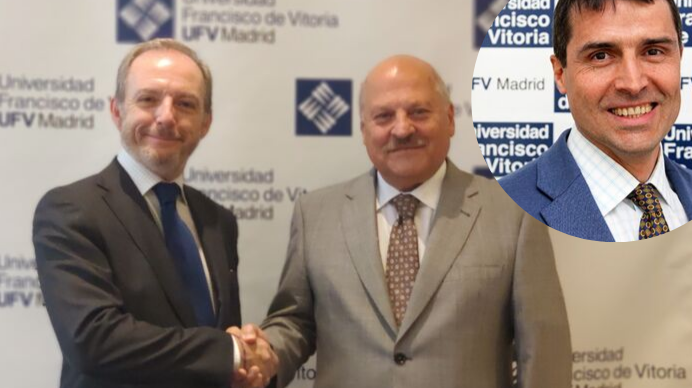
As previously announced, the Francisco de Vitoria University (UFV; Madrid, Spain) formalized last Friday (September 13) its participation in the project to implement the Practicum Script clinical reasoning training simulator for medical students rotating in Internal Medicine. The agreement signing, which took place in the dean’s hall at the university, brought together José Antonio Verdejo, secretary-general of the UFV, and Dr Hornos, president of the Practicum Institute. We used the opportunity to interview Prof Emilio Cervera, vice dean of practices and health centers of UFV and the main promoter of the agreement.
Madrid, September 17, 2019. To Prof Cervera, the main attraction of this pilot study – which has been jointly coordinated by the Practicum Institute and the European Board of Medical Assessors – is that the clinical scenarios presented are very rich and reflect the clinical reality. In fact, the professor mentioned that “The power of the tool is that it presents cases adapted to students in the last two years [of medical school], with various diagnostic possibilities, leading them to reason that they are all feasible in a certain order of probability according to the symptoms and the clinical data collected.” He thinks that medicine is not an absolute science.
Without further delay, here are the questions:
In medicine, is questioning a weakness?
Questioning in medicine is innate to a physician’s clinical decision and diagnostic process. Uncertainty in medicine is something we try to mitigate by resorting to sophisticated diagnostic procedures that have their own limitations, which we must take into account when making decisions. Clinical uncertainty is intrinsic to performance.
Medicine deals with diseases that are known and with patients who bring in the variability. We have just started learning about many issues in medicine, for example, why myocardial infarction and acute coronary syndrome do not present with the same symptoms in men and women. But there are many other things that we still don't know, like issues related to the pre-symptomatic or the subclinical period of the diseases.
In this sense, to be able to provide students with a tool that allows them to consider that their diagnostic resources (technological or thinking skills) have limitations and that they have to be open to contemplate scenarios of uncertainty in which they have to make decisions that are not 100% safe, connects them with the clinical reality. This will make them more cautious and will lead them to reflect on the patient and the clinical reasoning process.
In your opinion, what could contribute to go beyond the format of the single correct answer?
In simulation, for example, we work here with many students, and we see that when you present a case that seems to directly lead to a specific diagnosis, they close the perspective to other possibilities. When you make them face uncertainty or just open their perspective to other diagnostic possibilities, they are much more thorough in terms of history taking and questioning the patient, and in their steps to reach the diagnosis. They are much more systematic, ask more questions, explore more, raise the possibility of diagnostic tests, or come up with questions about the outcome of these diagnostic tests when they do not match the hypothesis. I believe that introducing students to questioning the fact that an investigation of symptoms does not lead to a single diagnostic possibility is always a rich contribution.
What are the strengths of Practicum Universities?
It is a method that is guaranteed by the continuing professional development cycle. Students expect to be presented with a case to be approached in different ways; the objective is for them to understand that the case may have different responses, and the probability of the range of responses may not be 100%. The tool has the power of broadening perspectives and leading to the understanding that medicine is a probabilistic science.
Do you have long-term expectations?
First, let's see what happens. Once the results of the pilot [study] are evaluated, we will see how to incorporate [this tool]. If the tool demonstrates what it seems to be capable of doing, the advantage is that we can incorporate it as an additional instrument that students can use even from home. This is a very important advantage: that the student may be working from home while studying the subjects that correspond to the possible diagnoses of the case.
The course has just begun, would you modify any aspect of the medical curriculum?
At the school’s administration level, we have been working on modifying and adapting the curriculum to the new teaching/learning modalities. The incorporation of innovative teaching methodologies is on the agenda. We will resort to this tool if we find it useful. It encompasses one possibility within others.
The way of teaching medicine must change because the profile of our patients and of students starting medical school is changing along with the health care system. With the perspective of the emergence of new health care models and new technologies to treat patients, change is inevitable. However, there are issues to be preserved, like patients’ follow-up, communication, professional values, ethics, or human aspects. These are all “pearls” that we don't want to lose. However, it is true that, although we have different activities, like integrated simulation scenarios or work with clinical cases, clinical reasoning is not properly contemplated.
How can we not change when, for example, intelligent electronic medical records suggesting diagnostic possibilities are incorporated? We must consider a multitude of factors. Young individuals are not all the same, and neither is the access and ease with which they use many innovations. Not to mention current information technologies. All social networks, the use of the internet, the internet for patients... All these things bring new challenges. Youngsters of today are not like those of 20 years ago, who watched a master class and then went on to [study from] books.
Our personalized help center enables you to obtain technical support and help for navigating through the site and using the program.